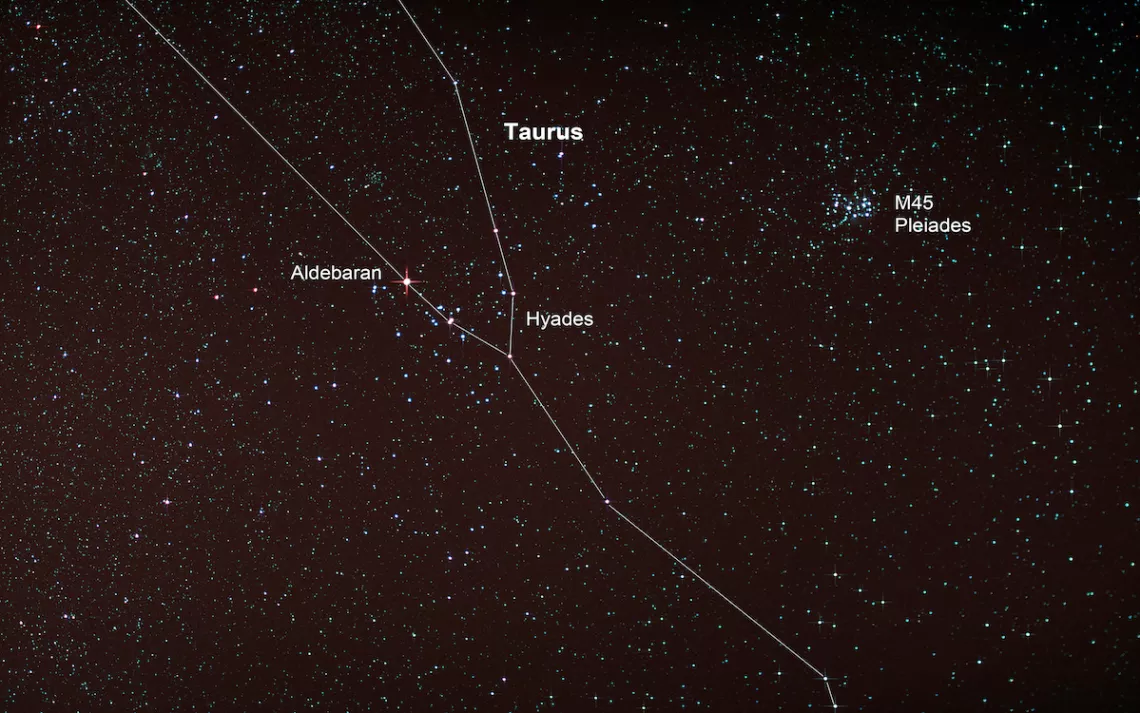November Astronomical Highlight: the Clusters and Nebulae of Taurus
It’s all bull all month long

Photo by 3quarks/iStock
In November, the constellation of Taurus comes into prominent view, rising in the east-northeast early in the evening. This timing makes it perfect for observing on after-dinner walks. The two most distinctive features for finding Taurus are the Hyades, a V-shaped cluster of stars that includes bright-orangish Aldebaran, and the Pleiades, a compact cluster of stars that looks like a tiny dipper.
The Hyades forms the head of Taurus the bull while the Pleiades sits above the bull’s head and is not incorporated into the shape of the bull itself. The Pleiades, or seven sisters, is one of the most beautiful objects to observe through binoculars. A telescope in this case is overkill because the close-up view will cut out some members of this sparkling sisterhood.
Taurus is also home to the first object recorded by famed astronomer Charles Messier in the 1700s. M1, also known as the Crab Nebula, is found near the horns of the bull. Follow the V-shape of Taurus’s head way back to two fairly bright stars, El Nath (the brighter of the two) and Zeta Tauri. The Crab Nebula lies approximately 1 degree (a pinky width held at arm’s length) from Zeta Tauri, toward Aldebaran. It is 6,500 light-years from Earth.
The Crab Nebula is the remnant of a supernova that Chinese astronomers observed to have exploded in 1054 A.D. The supernova was so bright that it was visible in the daytime sky for weeks and in the nighttime sky for almost two years.
The 8.4 magnitude nebula is made of the material that exploded outward in the supernova. M1 is visible with binoculars and appears as an oval haze through small scopes. Large-size telescopes may reveal some of the filament structures in the gas cloud.
For more of a challenge, try looking for the Merope and Maia Nebulae in the Pleiades. Finding them will require a telescope and excellent conditions—the stars of the Pleiades may be easy to spot, but the faint wisps of gas cloud that encircle them take a bit of luck.
Another unique location associated with Taurus is the barely visible Milky Way that flows past the star El Nath. In the summer, we can see the galactic center of the Milky Way galaxy in the region of Sagittarius, but in winter we can look toward the “galactic anticenter.” This is the region that is still part of the Milky Way’s disk but is on the quiet outskirts, or some of the farthest reaches that aren’t yet in intergalactic space. This sparse, “backwoods” region of the Milky Way makes the sky look a bit darker in winter than in summer, when a thicker, brighter section of the Milky Way floats in the sky.
Taurus will become an especially good constellation to observe next month when Comet Wirtanen makes its closest approach to Earth around December 15, passing between Aldebaran and the Pleiades. The comet is predicted to be as bright as third magnitude around this date, although keep in mind that this is a diffuse object and not a point of light.
In the meantime, you can search for Comet Wirtanen in November and maybe catch it as it is getting brighter. Wirtanen is set to be the 10th closest comet to us in modern times, skimming about 30 lunar distances from Earth. In mid-evening, look south-southeast not far from the horizon, near the constellation Fornax. This region is very lightly populated with stars or any bright signposts to help guide your way. Your best bet may be to start by looking straight overhead to find the W shape of Cassiopeia and then following the right side of the W like an arrow pointing all the way back to the horizon and Fornax. By December, the comet will speed up its progress as it brightens and aims for Taurus.
The last highlight in Taurus for November is the full moon on November 22 at 9:39 P.M. PST. November’s full moon is sometimes called the beaver moon.
Planets and Meteors in November
This month, Jupiter and Mercury hover near the horizon after sunset. If you’re headed southwest on your commute home, you may spot them before they set for the evening. With sunset jumping up a whole hour when daylight saving time ends on November 4, you’ll have plenty of time in the evening to scour the night sky for other planets.
On November 9, Mercury and Antares skim the horizon as the crescent moon makes an appearance. The next two nights the moon will slowly grow its crescent shape as it approaches and then passes yellowish Saturn and the Milky Way. On November 15, the moon is by Mars, still shining reddish and fairly bright after its opposition this summer.
Look for Leonid meteors streaking across the sky any time between November 5 and 30. The shower peaks overnight from November 17 to 18. The best time to watch is in the early morning hours before dawn.
 The Magazine of The Sierra Club
The Magazine of The Sierra Club



